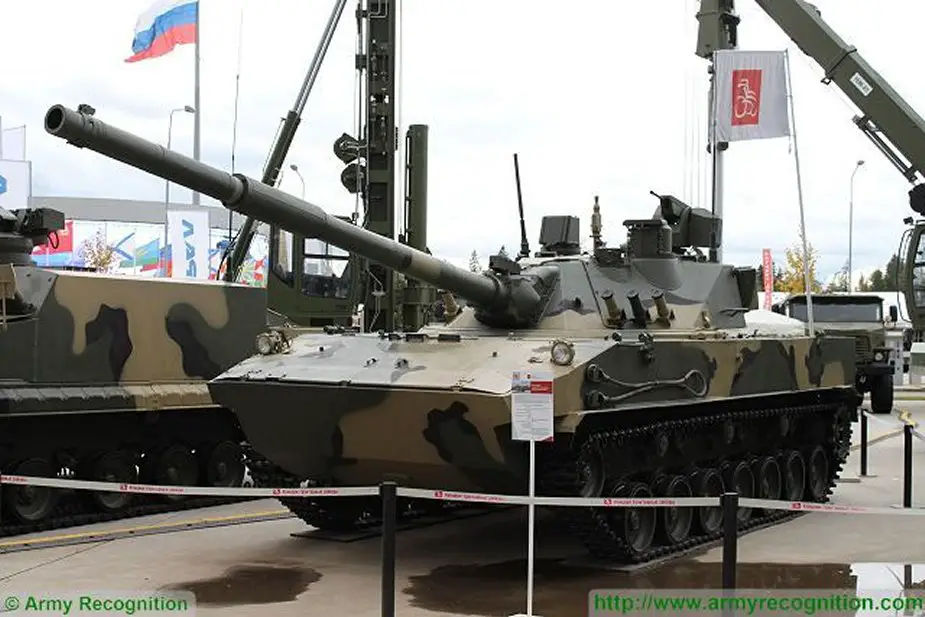The serial manufacturing of the upgraded Sprut-SDM1 self-propelled anti-tank guns (SPATG) will start in Russia in 2018, according to the Zvezda TV channel. The first indigenous developments of an air-droppable heavy-armed armored vehicle date back to the 1970s. The Object 934 became one of the first platforms that partially met the requirements of the Airborne Troops (VDV).

A Russian Sprut SDM1 Self-Propelled Anti-Tank Gun
The aforementioned vehicle satisfied most of the requirements to the Model 1970 VDV`s fire support systems. By the mid-1980s, the developers designed a unique Object 934-based technical solution - a light air-droppable vehicle with an anti-tank gun that could not only cross a rugged terrain at a high speed, but also fire when swimming.
The main difference between the Sprut SPATG and light airborne infantry fighting vehicles (AIFV) is the 125 mm 2A75 gun. Owing to the gun with advanced ballistics, the units that were planned to be fitted with the Sprut-SD by the command received unique combat performance that facilitated preparation and clearing of an airhead in landing area, as well as offensive and defensive actions of the airborne troops. However, the 1990s posed a hindrance to the saturation of the military with the SPATG. At the same time, the issue of the refinement and production of the prospective vehicle emerged again in the early 2000s, and the work made a sharp comeback. The state trials were conducted within several years, as well as the drop weight tests that confirmed the correctness of design solutions and the stability of functioning of the onboard electronics, weapon systems and control units after a bounce.
Special attention was paid to the armament suite of the Sprut-SD SPATG brought into service in 2005. Fifteen various rounds for the 2A75 gun ranging from high-explosive fragmentation (HE-Frag) to armour-piercing caliber-reduced (APCR) and high-explosive anti-tank (HEAT) that could destroy a protected object or a tank at a distance of 5 km were developed. The ammunition load also comprised anti-tank guided missiles (ATGM). Therefore, the airborne troops essentially received a unique combat vehicle that combined a tank`s power and unification in terms of munitions with an AIFV`s high maneuverability.
According to the commanders of anti-tank platoons, not only the Sprut-SD is an anti-tank self-propelled gun, but also a sniper and sabotage platform. "Not only can the Sprut arrange ambushes, but also change a position when detected by enemy. The Russian-made main battle tanks [MBT] can quickly leave a position after a shot; however, the difference in weight takes its toll," the servicemen emphasized, according to Zvezda.
The military points out the vehicle`s ability to conduct fire when crossing water obstacles. A large interior volume, water jets, air-filled road wheels and a trim vane allow crashing a water obstacle on the run.
The serial production of the upgraded vehicle of the type is planned to be launched in 2018. Despite similarity of the Sprut-SDM1 to the with the vehicle of previous generation, it possesses a number of key features including a modernized BMD-4M chassis, remade electronics and an integration with a tactical-level automated control system that turns the universal SPATG into a reconnaissance platform being able to send target information to other units. The experts point out that the airborne troops have received not only a fire support system, but also a combat vehicle with a firepower equal to the T-72 and T-90 MBTs that can accomplish tasks without involving of additional assets. Zvezda says.
The Sprut-SD and Sprut-SDM1 cannot be compared with similar foreign-originated vehicles, as they have no analogous airborne platforms in terms of combat capabilities and performance. The US and European wheeled tanks with less powerful guns that cannot be airdropped by an airlifter are the closest competitors, Zvezda points out quoting the specialists as saying.
According to the experts, the term 'landing' of an armoured vehicle is different in Russia and NATO state members: while the Soviet/Russian Airborne Troops use parachute systems and shock-absorbing constructions for safe and rapid airdropping, the US Department of Defense (DoD) and the defense ministries of NATO countries declined to develop such systems, having concentrated on the improving of the military logistics.
"Apart from Russia, only the People`s Republic of China [PRC] is developing air-droppable armoured vehicles. However, they [the Chinese] operate only light AIFVs that lack heavy armaments. The 105 mm wheeled self-propelled guns provide a kind of helping hand; at the same time, their cross-country capability is less than that of tracked armoured vehicles," expert Vasily Kashin pointed out in an interview with the Zvezda TV channel.
The specialists point out that enhanced onboard electronics, an ammunition load of 40 rounds and excellent cross-country capability coupled with speed and maneuverability may have an impact on the stand-off between tank destroyers and imaginary enemy`s MBTs. They expect that this issue might influence the export outlook of the vehicle, the Zvezda TV channel says.
© Copyright 2017 TASS. All rights reserved. This material may not be published, broadcast, rewritten or redistributed.














